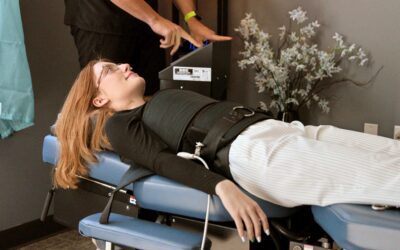Have you been suffering from low back pain and tight hamstrings? Maybe you’ve noticed that you tend to lean forward these days. If you’re suffering from chronic back pain, it could be from spondylolisthesis, which is the medical term for a vertebra that is slipping.
It’s a common cause of chronic back pain and can greatly affect one’s quality of life, making even routine activities daunting.
What Is Spondylolisthesis?
Your vertebrae are the small, circular bones that are stacked together to make up your spinal column. If a vertebra gets displaced, it causes spondylolisthesis.
Sometimes the vertebra will also press on a nerve, causing burning or numbness to radiate down the leg.
Spondylolisthesis is not the same thing as a slipped disc. Normally when someone says they have a slipped disc, what they actually have is a herniated disc which means the disc has ruptured.
Symptoms Of Spondylolisthesis
Spondylolisthesis can cause complications like nerve compression or osteoarthritis. Symptoms may include:
- Low back pain
- Loss of bladder control
- Weakness in legs
- Tightness in hamstrings
- Tenderness in the spine, specifically where the vertebra is dislodged
- Stiffness that affects how you walk or stand, usually causing you to lean forward
- Waddling as you walk
Causes Of Spondylolisthesis
People of any age can suffer from spondylolisthesis. Infants can have it from a birth injury, and adolescents may deal with it as they get taller. Activities like weightlifting, football, and gymnastics can stress the lower back and cause bones to shift. Those suffering from arthritis and other ailments that wear out the cartilage and bones are susceptible, too.
Types Of Spondylolisthesis
- Degenerative means the parts of the back have degenerated over time, often due to arthritis.
- Isthmic is caused by spondylolysis, a type of fracture often caused by repetitive stress injuries that overstrain the back.
- Congenital means a birth defect has affected normal growth in the spine.
- Traumatic is caused by acute injury that forces the vertebrae out of alignment.
- Pathologic results from a bone disease like osteoporosis, or a tumor.
- Iatrogenic is when the spine is destabilized during surgery.
Diagnosing Spondylolisthesis
To diagnose spondylolisthesis, your chiropractor will rely on a combination of the patient’s medical history, physical examinations, and imaging tests.
During a physical examination, your chiropractor will ask about the patient’s symptoms, such as the exact location and nature of the pain, what activities exacerbate it, and what provides relief.
The examination often involves assessing the spine’s range of motion and might involve specific movements or postures to see if they trigger symptoms.
Imaging tests like X-rays, CT scans, or MRIs provide detailed views of the spine, revealing if a vertebra is out of place, and can help to rule out other potential causes of back pain.
We’re Here To Help
If a diagnosis of spondylolisthesis is confirmed, your chiropractor can provide significant aid in managing and treating the condition.
With the primary focus of chiropractic care being the optimal alignment of the spine, we can leverage multiple techniques to help patients with spondylolisthesis.
Treatment plans are personalized to the patient’s specific condition, pain levels, and overall health. These often involve spinal adjustments to improve the alignment of the vertebrae, which can reduce pain and improve spinal function.
In addition to adjustments, chiropractic care often incorporates specific therapeutic exercises to strengthen the muscles supporting the spine, improving overall spinal health, and minimizing the risk of further slippage.
Chiropractic care can also promote better posture, another important aspect of managing spondylolisthesis. Incorrect posture can add strain to the spine and contribute to the progression of spondylolisthesis.
By educating patients about the correct posture and providing exercises that promote postural correction, chiropractors can help mitigate this risk.
Chiropractors can also provide advice on lifestyle modifications, such as weight management and avoidance of certain high-impact activities, that can exacerbate spondylolisthesis.
Each patient is unique and may respond differently to various forms of treatment. But in many cases, chiropractic care has proven to be a reliable, non-invasive solution for managing spondylolisthesis and its associated symptoms, enabling patients to lead a more comfortable and active life.
While spondylolisthesis can be a source of significant discomfort and chronic back pain, a proper understanding of the condition coupled with the right care can go a long way in managing its symptoms and improving one’s quality of life.
If you or a loved one are experiencing symptoms that could be related to spondylolisthesis, do not hesitate to reach out to our office to explore how chiropractic care could help you.
Call 417 Spine to schedule an appointment and start conquering your pain.


